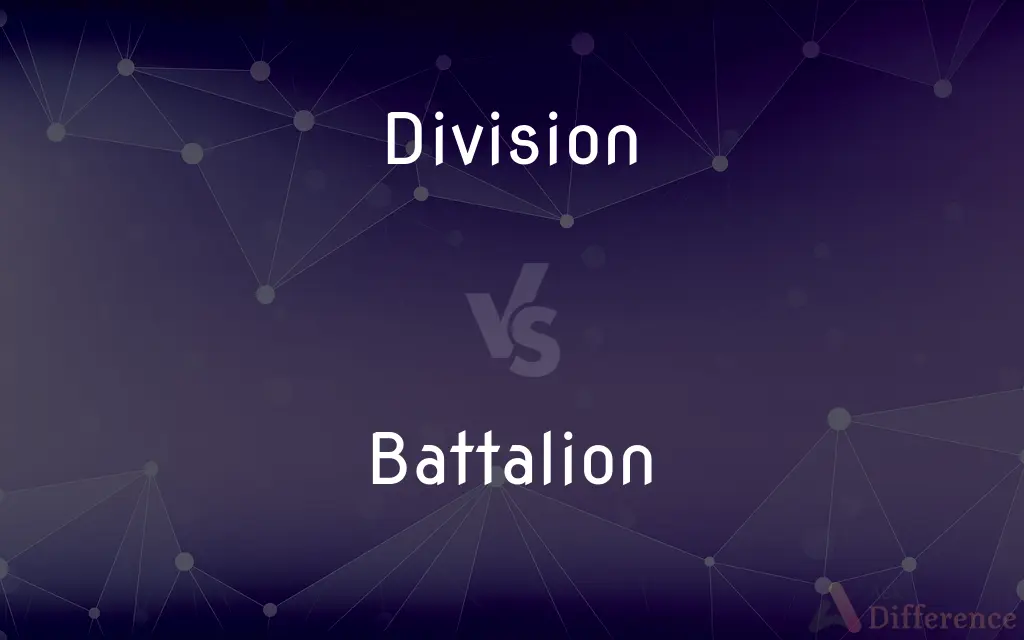Division vs. Battalion — What's the Difference?
Edited by Tayyaba Rehman — By Urooj Arif — Updated on March 28, 2024
A division is a large military unit typically commanded by a major general, while a battalion is a smaller unit usually commanded by a lieutenant colonel.

Difference Between Division and Battalion
Table of Contents
ADVERTISEMENT
Key Differences
In military organization, a division is a significant unit that usually consists of 10,000 to 20,000 soldiers, commanded by a major general. It's structured to perform major tactical operations and conduct sustained battles and engagements. On the other hand, a battalion is a smaller unit, consisting of 300 to 1,000 soldiers, usually commanded by a lieutenant colonel. Battalions are the basic building blocks of an army's structure, typically consisting of two to six companies.
While divisions have the manpower, resources, and organizational complexity to undertake large-scale operations over extended periods, battalions are more maneuverable and can be rapidly deployed for specific tasks. The operational scope of a division encompasses a broader strategic level, involving large segments of the battlefield and coordinating multiple battalions and brigades for unified action. In contrast, battalions are more focused on tactical objectives, capable of detailed, ground-level operations but requiring support and directives from higher command levels for larger strategic contexts.
The distinction between divisions and battalions reflects not only size and command but also their roles and capabilities within military operations. Divisions are equipped to sustain long-term operations and exert control over significant areas, including providing logistical, artillery, intelligence, and other supports to their subordinate units. Battalions, while versatile and critical to fulfilling strategic objectives, operate within the framework set by the broader goals of their parent divisions or brigades, focusing on achieving specific mission objectives.
In summary, the primary differences lie in their size, command structure, operational capabilities, and the level at which they engage in military strategy and tactics. Divisions are larger, more self-sufficient units capable of conducting operations on a grand scale, while battalions are smaller, agile units focused on specific tactical missions within the larger strategy.
Comparison Chart
Size
10,000 to 20,000 soldiers
300 to 1,000 soldiers
ADVERTISEMENT
Command
Major General
Lieutenant Colonel
Composition
Several brigades or regiments
Two to six companies
Operational Scope
Major tactical operations, sustained battles
Specific tactical missions, part of larger operations
Strategic Level
Broad, involving large segments of the battlefield
Focused, within the framework of broader goals
Autonomy
Capable of independent operation
Operates under higher command within divisions or brigades
Support
Includes logistical, artillery, intelligence support
Requires support from higher command for broader strategy
Compare with Definitions
Division
Commanded by a major general.
Major General Smith took command of the division last year.
Battalion
A smaller military unit focused on specific missions.
The battalion secured the strategic bridge overnight.
Division
Structured with several brigades or regiments.
The division comprises three brigades, each with specialized capabilities.
Battalion
Usually commanded by a lieutenant colonel.
Lieutenant Colonel Davis leads the battalion with distinction.
Division
A large military unit capable of independent operations.
The 1st Infantry Division has a storied history in several major conflicts.
Battalion
Consists of two to six companies.
The battalion organized its companies for the upcoming operation.
Division
Engages in sustained battles and engagements.
The division was deployed for a prolonged operation in the mountainous region.
Battalion
Integral to larger brigade or regiment strategies.
The battalion's mission was a key part of the brigade's offensive.
Division
Operates on a broad strategic level.
The division's movements are crucial to the broader campaign's success.
Battalion
Requires support for broader strategic objectives.
The battalion awaited further orders to align with the division's strategy.
Division
The action of separating something into parts or the process of being separated
A gene that helps regulate cell division
The division of the land into small fields
Battalion
A battalion is a military unit, typically consisting of 300 to 1000 soldiers commanded by a lieutenant colonel, and subdivided into a number of companies. In some countries, battalions are exclusively infantry, while in others battalions are unit-level organizations.
Division
Difference or disagreement between two or more groups, typically producing tension
A growing sense of division between north and south
Deep cultural divisions
Battalion
A military unit typically consisting of a headquarters and two or more companies, batteries, or similar subunits.
Division
The process of dividing one number by another
No multiplication or division is necessary
Battalion
A large body of organized troops.
Division
Each of the parts into which something is divided
The main divisions of the book
Battalion
A great number
Battalions of ants.
Division
A partition
The villagers lived in a communal building and there were no solid divisions between neighbours
Battalion
(military) An army unit having two or more companies, etc. and a headquarters. Traditionally forming part of a regiment.
Division
The act or process of dividing.
Battalion
An army unit having two or more companies, etc. and a headquarters; forming part of a brigade.
Division
The state of having been divided.
Battalion
Any large body of troops.
Division
(Mathematics) The operation of determining how many times one quantity is contained in another; the inverse of multiplication.
Battalion
(by extension) A great number of things.
Division
The proportional distribution of a quantity or entity
The division of his property among his heirs.
Battalion
To form into battalions.
Division
Something, such as a boundary or partition, that serves to divide or keep separate.
Battalion
A body of troops; esp. a body of troops or an army in battle array.
Division
One of the parts, sections, or groups into which something is divided.
Battalion
An infantry command of two or more companies, which is the tactical unit of the infantry, or the smallest command which is self-supporting upon the battlefield, and also the unit in which the strength of the infantry of an army is expressed.
Division
An area of government or corporate activity organized as an administrative or functional unit.
Battalion
To form into battalions.
Division
A territorial section marked off for political or governmental purposes.
Battalion
An army unit usually consisting of a headquarters and three or more companies
Division
An administrative and tactical military unit that is smaller than a corps but is self-contained and equipped for prolonged combat activity.
Battalion
A large indefinite number;
A battalion of ants
A multitude of TV antennas
A plurality of religions
Division
A group of several ships of similar type forming a tactical unit under a single command in the US Navy.
Division
A former unit of the US Air Force that was larger than a wing and smaller than an air force.
Division
(Botany) The taxonomic category ranking just below kingdom, consisting of one or more related classes, and corresponding approximately to a phylum in zoological classification.
Division
A category created for purposes of competition, as in boxing.
Division
Variance of opinion; disagreement.
Division
A splitting into factions; disunion.
Division
The physical separation and regrouping of members of a parliament according to their stand on an issue put to vote.
Division
(Biology) Cell division.
Division
A type of propagation characteristic of plants that spread by means of newly formed parts such as bulbs, suckers, or rhizomes.
Division
(uncountable) The act or process of dividing anything.
Division
Each of the separate parts of something resulting from division.
Division
The process of dividing a number by another.
Division
(arithmetic) A calculation that involves this process.
I've got ten divisions to do for my homework.
Division
(military) A formation, usually made up of two or three brigades.
Division
A usually high-level section of a large company or conglomerate.
Division
(taxonomy) A rank below kingdom and above class, particularly used of plants or fungi, also (particularly of animals) called a phylum; a taxon at that rank.
Magnolias belong to the division Magnoliophyta.
Division
A disagreement; a difference of viewpoint between two sides of an argument.
Division
(government) A method by which a legislature is separated into groups in order to take a better estimate of vote than a voice vote.
The House of Commons has voted to approve the third reading of the bill without a division. The bill will now progress to the House of Lords.
Division
(music) A florid instrumental variation of a melody in the 17th and 18th centuries, originally conceived as the dividing of each of a succession of long notes into several short ones.
Division
(music) A set of pipes in a pipe organ which are independently controlled and supplied.
Division
(legal) A concept whereby a common group of debtors are only responsible for their proportionate sum of the total debt.
Division
(computing) Any of the four major parts of a COBOL program source code.
Division
A lesson; a class.
Division
(Australia) A parliamentary constituency.
Division
The act or process of diving anything into parts, or the state of being so divided; separation.
I was overlooked in the division of the spoil.
Division
That which divides or keeps apart; a partition.
Division
The portion separated by the divining of a mass or body; a distinct segment or section.
Communities and divisions of men.
Division
Disunion; difference in opinion or feeling; discord; variance; alienation.
There was a division among the people.
Division
Difference of condition; state of distinction; distinction; contrast.
I will put a division between my people and thy people.
Division
Separation of the members of a deliberative body, esp. of the Houses of Parliament, to ascertain the vote.
The motion passed without a division.
Division
The process of finding how many times one number or quantity is contained in another; the reverse of multiplication; also, the rule by which the operation is performed.
Division
The separation of a genus into its constituent species.
Division
Two or more brigades under the command of a general officer.
Division
One of the groups into which a fleet is divided.
Division
A course of notes so running into each other as to form one series or chain, to be sung in one breath to one syllable.
Division
The distribution of a discourse into parts; a part so distinguished.
Division
A grade or rank in classification; a portion of a tribe or of a class; or, in some recent authorities, equivalent to a subkingdom.
Division
An army unit large enough to sustain combat;
Two infantry divisions were held in reserve
Division
One of the portions into which something is regarded as divided and which together constitute a whole;
The written part of the exam
The finance section of the company
The BBC's engineering division
Division
The act or process of dividing
Division
An administrative unit in government or business
Division
An arithmetic operation that is the inverse of multiplication; the quotient of two numbers is computed
Division
Discord that splits a group
Division
A league ranked by quality;
He played baseball in class D for two years
Princeton is in the NCAA Division 1-AA
Division
(biology) a group of organisms forming a subdivision of a larger category
Division
(botany) taxonomic unit of plants corresponding to a phylum
Division
A unit of the United States Air Force usually comprising two or more wings
Division
A group of ships of similar type
Division
The act of dividing or partitioning; separation by the creation of a boundary that divides or keeps apart
Common Curiosities
Can a battalion operate independently?
Yes, battalions can operate independently for specific tactical missions but are often part of larger operations that coordinate multiple battalions and other units.
What is the role of a division in a military campaign?
A division's role in a military campaign is to conduct major operations, control significant areas of the battlefield, and coordinate the efforts of its subordinate units toward strategic objectives.
Are there different types of battalions?
Yes, there are various types of battalions, including infantry, artillery, engineer, and support battalions, each specializing in different tactical missions and support roles.
What determines the size of a division?
The size of a division is determined by its intended operational role, including the nature of missions, the terrain, and the military strategy it's designed to execute.
What makes a division capable of sustained operations?
A division's capability for sustained operations comes from its size, diverse unit composition, and ability to provide comprehensive support to its units, enabling prolonged engagement in combat or strategic positions.
How is the success of a battalion measured?
The success of a battalion is measured by its effectiveness in achieving specific tactical objectives, the efficiency of its operations, and its ability to integrate within larger strategic plans.
Can divisions and battalions be part of international coalitions?
Yes, divisions and battalions can be part of international coalitions, contributing to joint operations and sharing strategic objectives with allied forces.
How do divisions support their battalions?
Divisions provide logistical, artillery, intelligence, and other support to their battalions, ensuring they have the resources and information needed for their operations.
What is the significance of a battalion within a division?
A battalion is significant within a division as a key operational component, executing specific tasks that contribute to the division's overall mission and strategic goals.
How does command structure differ between divisions and battalions?
Divisions are commanded by major generals and have a broader command structure, including multiple brigades or regiments, while battalions, commanded by lieutenant colonels, have a more focused command over companies.
Share Your Discovery

Previous Comparison
Resent vs. Dislike
Next Comparison
Elis vs. EllisAuthor Spotlight
Written by
Urooj ArifUrooj is a skilled content writer at Ask Difference, known for her exceptional ability to simplify complex topics into engaging and informative content. With a passion for research and a flair for clear, concise writing, she consistently delivers articles that resonate with our diverse audience.
Edited by
Tayyaba RehmanTayyaba Rehman is a distinguished writer, currently serving as a primary contributor to askdifference.com. As a researcher in semantics and etymology, Tayyaba's passion for the complexity of languages and their distinctions has found a perfect home on the platform. Tayyaba delves into the intricacies of language, distinguishing between commonly confused words and phrases, thereby providing clarity for readers worldwide.















































